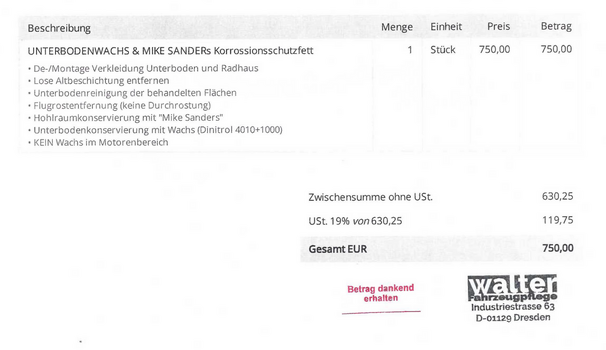Having trawled through all the posts and views on what underbody treatment (if any) to use, I’m looking at going the Dinitrol route.
Firstly, it’s not a quick DIY application; it’s a three day paid for service, by an approved provider. Ergo, it’s going to be expensive.
My neighbour has had a couple of his vehicles done, and couldn’t fault it.
With DIY products, at best they’re only as good as the person applying it, and unless you’re a professional user, then you’re probably going to be taking shortcuts (ie not removing wheels, wheel arches etc).
The process begins with the removal of wheels, arch protectors, covers and any other ancillary parts that hold dirt, and prevents access to the spray gun. Photos are taken of all areas, as well as the customer being notified of areas where rust treatment is required prior to proceeding any further.
The vehicle is then thoroughly pressure washed until properly clean.
Next it’s steam cleaned until any oil or grease based dirt is removed.
Then it’s blow dried, and left in a heated room until absolutely dry. This may take a day/night.
Once proven dry, it’s masked up (prop shaft, engine, transfer box, gearbox, brakes, exhaust, etc).
Then the Dinitrol is applied to the required surfaces.
Other Dinitrol products are then applied to wheel arches, door sills and other parts where the standard Dinitrol is not needed.
Stone chip coatings are then applied to the more vulnerable or exposed parts. It would appear that a number of Dinitrol products are used in combination.
Once photographed again, the vehicle is unmasked, reassembled and left to cure.
The price includes the first 12 month follow up check and reapplication of product(s) where/if required.
Has anyone else had any experience with Dinitrol?
There happens to be an approved Dinitrol provider within 10 miles of where I live, so I’m more than curious as to whether this is the route to go.
I’m reluctant to take Ineos’s word that their treatments are up to it, and as commented on other posts, it’s the fixtures and fittings that are most at risk, not necessarily the chassis.
Any thoughts and comments welcomed on this much discussed topic.
Firstly, it’s not a quick DIY application; it’s a three day paid for service, by an approved provider. Ergo, it’s going to be expensive.
My neighbour has had a couple of his vehicles done, and couldn’t fault it.
With DIY products, at best they’re only as good as the person applying it, and unless you’re a professional user, then you’re probably going to be taking shortcuts (ie not removing wheels, wheel arches etc).
The process begins with the removal of wheels, arch protectors, covers and any other ancillary parts that hold dirt, and prevents access to the spray gun. Photos are taken of all areas, as well as the customer being notified of areas where rust treatment is required prior to proceeding any further.
The vehicle is then thoroughly pressure washed until properly clean.
Next it’s steam cleaned until any oil or grease based dirt is removed.
Then it’s blow dried, and left in a heated room until absolutely dry. This may take a day/night.
Once proven dry, it’s masked up (prop shaft, engine, transfer box, gearbox, brakes, exhaust, etc).
Then the Dinitrol is applied to the required surfaces.
Other Dinitrol products are then applied to wheel arches, door sills and other parts where the standard Dinitrol is not needed.
Stone chip coatings are then applied to the more vulnerable or exposed parts. It would appear that a number of Dinitrol products are used in combination.
Once photographed again, the vehicle is unmasked, reassembled and left to cure.
The price includes the first 12 month follow up check and reapplication of product(s) where/if required.
Has anyone else had any experience with Dinitrol?
There happens to be an approved Dinitrol provider within 10 miles of where I live, so I’m more than curious as to whether this is the route to go.
I’m reluctant to take Ineos’s word that their treatments are up to it, and as commented on other posts, it’s the fixtures and fittings that are most at risk, not necessarily the chassis.
Any thoughts and comments welcomed on this much discussed topic.




